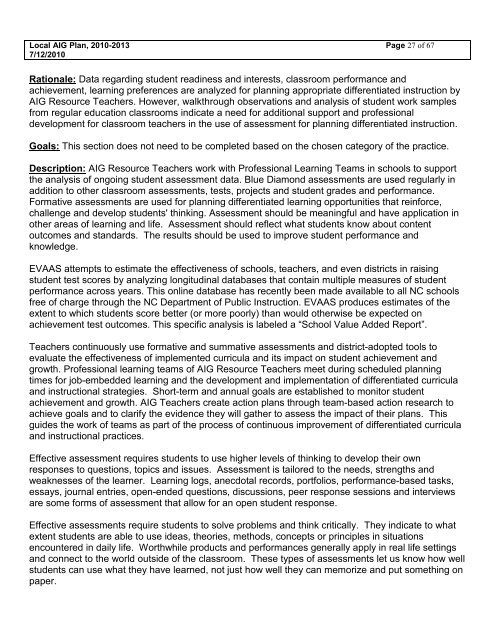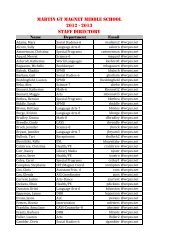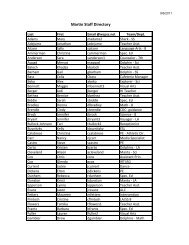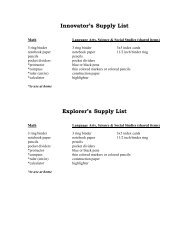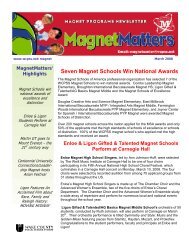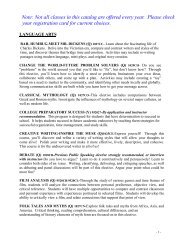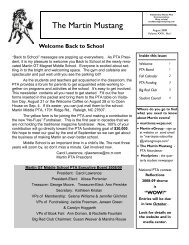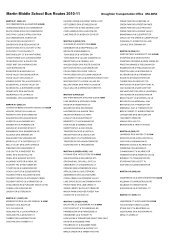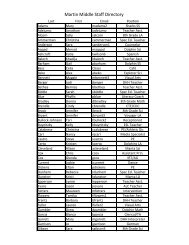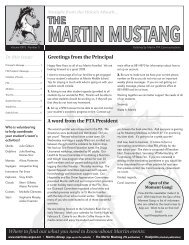Wake County Schools Local Academically or Intellectually Gifted ...
Wake County Schools Local Academically or Intellectually Gifted ...
Wake County Schools Local Academically or Intellectually Gifted ...
Create successful ePaper yourself
Turn your PDF publications into a flip-book with our unique Google optimized e-Paper software.
<strong>Local</strong> AIG Plan, 2010-2013 Page 27 of 67<br />
7/12/2010<br />
Rationale: Data regarding student readiness and interests, classroom perf<strong>or</strong>mance and<br />
achievement, learning preferences are analyzed f<strong>or</strong> planning appropriate differentiated instruction by<br />
AIG Resource Teachers. However, walkthrough observations and analysis of student w<strong>or</strong>k samples<br />
from regular education classrooms indicate a need f<strong>or</strong> additional supp<strong>or</strong>t and professional<br />
development f<strong>or</strong> classroom teachers in the use of assessment f<strong>or</strong> planning differentiated instruction.<br />
Goals: This section does not need to be completed based on the chosen categ<strong>or</strong>y of the practice.<br />
Description: AIG Resource Teachers w<strong>or</strong>k with Professional Learning Teams in schools to supp<strong>or</strong>t<br />
the analysis of ongoing student assessment data. Blue Diamond assessments are used regularly in<br />
addition to other classroom assessments, tests, projects and student grades and perf<strong>or</strong>mance.<br />
F<strong>or</strong>mative assessments are used f<strong>or</strong> planning differentiated learning opp<strong>or</strong>tunities that reinf<strong>or</strong>ce,<br />
challenge and develop students' thinking. Assessment should be meaningful and have application in<br />
other areas of learning and life. Assessment should reflect what students know about content<br />
outcomes and standards. The results should be used to improve student perf<strong>or</strong>mance and<br />
knowledge.<br />
EVAAS attempts to estimate the effectiveness of schools, teachers, and even districts in raising<br />
student test sc<strong>or</strong>es by analyzing longitudinal databases that contain multiple measures of student<br />
perf<strong>or</strong>mance across years. This online database has recently been made available to all NC schools<br />
free of charge through the NC Department of Public Instruction. EVAAS produces estimates of the<br />
extent to which students sc<strong>or</strong>e better (<strong>or</strong> m<strong>or</strong>e po<strong>or</strong>ly) than would otherwise be expected on<br />
achievement test outcomes. This specific analysis is labeled a “School Value Added Rep<strong>or</strong>t”.<br />
Teachers continuously use f<strong>or</strong>mative and summative assessments and district-adopted tools to<br />
evaluate the effectiveness of implemented curricula and its impact on student achievement and<br />
growth. Professional learning teams of AIG Resource Teachers meet during scheduled planning<br />
times f<strong>or</strong> job-embedded learning and the development and implementation of differentiated curricula<br />
and instructional strategies. Sh<strong>or</strong>t-term and annual goals are established to monit<strong>or</strong> student<br />
achievement and growth. AIG Teachers create action plans through team-based action research to<br />
achieve goals and to clarify the evidence they will gather to assess the impact of their plans. This<br />
guides the w<strong>or</strong>k of teams as part of the process of continuous improvement of differentiated curricula<br />
and instructional practices.<br />
Effective assessment requires students to use higher levels of thinking to develop their own<br />
responses to questions, topics and issues. Assessment is tail<strong>or</strong>ed to the needs, strengths and<br />
weaknesses of the learner. Learning logs, anecdotal rec<strong>or</strong>ds, p<strong>or</strong>tfolios, perf<strong>or</strong>mance-based tasks,<br />
essays, journal entries, open-ended questions, discussions, peer response sessions and interviews<br />
are some f<strong>or</strong>ms of assessment that allow f<strong>or</strong> an open student response.<br />
Effective assessments require students to solve problems and think critically. They indicate to what<br />
extent students are able to use ideas, the<strong>or</strong>ies, methods, concepts <strong>or</strong> principles in situations<br />
encountered in daily life. W<strong>or</strong>thwhile products and perf<strong>or</strong>mances generally apply in real life settings<br />
and connect to the w<strong>or</strong>ld outside of the classroom. These types of assessments let us know how well<br />
students can use what they have learned, not just how well they can mem<strong>or</strong>ize and put something on<br />
paper.


